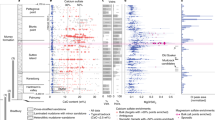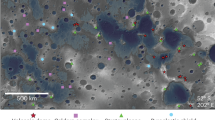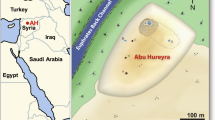Abstract
The martian surface features abundant volcanoes and evidence for past liquid water. Extant or relict martian volcanic hydrothermal systems have therefore been sought in the pursuit of evidence for habitable environments1. The Mars Exploration Rover, Spirit, detected deposits highly enriched in silica with accessory minerals, suggesting formation by hydrothermal leaching of basaltic rocks by low-pH solutions2. However, extensive erosion has obscured the context of the formation environment of these deposits. Silica deposits have also been identified remotely, but also with limited contextual clues to their formation; aqueous alteration products of basalt and volcanic ash are the most likely sources3,4. Here we report the detection from orbit of hydrated silica deposits on the flanks of a volcanic cone in the martian Syrtis Major caldera complex. Near-infrared observations show dozens of localized hydrated silica deposits. As a result of the morphology of these deposits and their location in and around the cone summit, we suggest that the deposits were produced by a volcanically driven hydrothermal system. The cone and associated lava flows post-date Early Hesperian volcano formation. We conclude that, if a relict hydrothermal system was associated with the silica deposits, it may preserve one of the most recent habitable microenvironments on Mars.
This is a preview of subscription content, access via your institution
Access options
Subscribe to this journal
Receive 12 print issues and online access
$259.00 per year
only $21.58 per issue
Buy this article
- Purchase on Springer Link
- Instant access to full article PDF
Prices may be subject to local taxes which are calculated during checkout



Similar content being viewed by others
References
Farmer, J. D. & Des Marais, D. J. Exploring for a record of ancient Martian life. J. Geophys. Res. 104, 26977–26995 (1999).
Squyres, S. W. et al. Detection of silica-rich deposits on Mars. Science 320, 1063–1067 (2008).
Milliken, R. E. et al. Opaline silica in young deposits on Mars. Geology 36, 847–850 (2008).
Ehlmann, B. L. et al. Identification of hydrated silicate minerals on Mars using MRO-CRISM: Geologic context near Nili Fossae and implication for aqueous alteration. J. Geophys. Res. 114, E00D08 (2009).
Hiesinger, H. & Head, J. W. III The Syrtis Major volcanic province, Mars: Synthesis from Mars global surveyor data. J. Geophys. Res. 109, E01004 (2004).
Mustard, J. F., Murchie, S. M., Erard, S. & Sunshine, J. In situ compositions of Martian volcanics: Implications for the mantle. J. Geophys. Res. 102, 25605–25615 (1997).
Rogers, A. D. & Christensen, P. R. Surface mineralogy of Martian low-albedo regions from MGS-TES data: Implications for upper crustal evolution and surface alteration. J. Geophys. Res. 112, E01003 (2007).
Crumpler, L. S., Head, J. W. & Aubele, J. C. Calderas on Mars: Characteristics, structure, and associated flank deformation. Geol. Soc. Spec. Pub. 110, 307–348 (1996).
Christensen, P. R. et al. Evidence for magmatic evolution and diversity on Mars from infrared observations. Nature 436, 504–509 (2005).
Anderson, J. H. Jr & Wickersheim, K. A. Near infrared characterization of water and hydroxyl groups on silica surfaces. Surf. Sci. 2, 252–260 (1964).
Goryniuk, M. C., Rivard, B. A. & Jones, B. The reflectance spectra of opal-A (0.5–25 μm) from the Taupo volcanic zone: Spectra that may identify hydrothermal systems on planetary surfaces. Geophys. Res. Lett. 31, L24701 (2004).
Milliken, R. E. PhD dissertation, Brown Univ. (2006).
Rice, M. S., Cloutis, E. A. & Crowley, J. K. Spectral reflectance changes accompanying long-duration exposure of silica sinter and Fe-sulfates to simulated Mars surface conditions. Abstr. Lunar Planet. Conf. 2576 (2010).
Sherman, D. M., Burns, R. G. & Burns, V. M. Spectral characteristics of the iron oxides with applications to the Martian bright region mineralogy. J. Geophys. Res. 87, 10169–10180 (1982).
Chemtob, S. M., Jolliff, B. L., Rossman, G. R., Eiler, J. M. & Arvidson, R. E. Silica coatings in the Ka’u Desert, Hawaii, a Mars analog terrain: A micromorphogical, spectral, chemical and isotopic study. J. Geophys. Res. 115, E04001 (2009).
Seelos, K. D. et al. Silica in a Mars analog environment: Ka’u Desert, Kilauea Volcano, Hawaii. J. Geophys. Res. 115, E00D15 (2010).
Pelkey, S. M. et al. CRISM multispectral summary products: Parameterizing mineral diversity on Mars from reflectance. J. Geophys. Res. 112, E08S14 (2007).
Rodgers, K. A. et al. Silica phases in sinters and residues form geothermal fields of New Zealand. Earth Sci. Rev. 66, 1–61 (2004).
Preston, L. J., Benedix, G. K., Genge, M. J. & Sephton, M. A. A multidisciplinary study of silica sinter deposits with applications to silica identification and detection of fossil life on Mars. Icarus 198, 331–350 (2008).
Schiffman, P., Zierenberg, R., Marks, N., Bishop, J. L. & Dyar, M. D. et al. Acid-fog deposition at Kilauea volcano: A possible mechanism for the formation of siliceous-sulfate rock coatings on Mars. Geology 34, 921–924 (2006).
McLennan, S. M. Sedimentary silica on Mars. Geology 31, 315–318 (2003).
Mustard, J. F. et al. Composition, morphology, and stratigraphy of Noachian crust around the Isidis basin. J. Geophys. Res. 114, E00D12 (2009).
McEwen, A. S. et al. Mars Reconnaissance Orbiter’s High Resolution Imaging Science Experiment (HiRISE). J. Geophys. Res. 112, E05S02 (2007).
Morris, R. V. et al. The hydrothermal system at Home Plate in Gusev crater, Mars: Formation of high silica material by acid-sulfate alteration of basalt. Abstr. Lunar Planet. Conf. 2208 (2008).
Ruff, S. W. et al. The nature and distribution of silica at Home Plate in Gusev crater, Mars: Evidence for a hydrothermal system. Abstr. Lunar Planet. Conf. 2213 (2008).
Tosca, N. J., McLennan, S. M., Lindsley, D. H. & Schoonen, M. A. A. Acid-sulfate weathering of synthetic Martian basalt: The acid fog model revisited. J. Geophys. Res. 109, E05003 (2004).
Aksyuk, A. M. The SiO2–H2O system along the lower three-phase curve and approximate values of critical end-point temperature. Eur. J. Mineral 9, 975–986 (1997).
Murchie, S. et al. Compact reconnaissance imaging spectrometer for Mars (CRISM) on Mars reconnaissance orbiter (MRO). J. Geophys. Res. 112, E05S03 (2007).
Malin, M. et al. Context camera investigation on board the Mars Reconnaissance Orbiter. J. Geophys. Res. 112, E05S04 (2007).
Christensen, P. R., Gorelick, N. S., Mehall, G. L. & Murry, K. C. THEMIS Public Data Releases, Planetary System node, Arizona State University, http://themis-data.asu.edu.
Acknowledgements
This work is supported by the CRISM investigation on MRO under contract from JPL. Thanks to the MRO team for data collection, I. Spitale for HiRISE targeting, and S. Ruff, M. Rice, D. Morris and K. Seelos for discussion and analysis help.
Author information
Authors and Affiliations
Contributions
J.R.S. initiated the study, conducted the analysis and wrote manuscript. J.F.M. provided guidance, improved analysis and defined the focus of the work. B.L.E. contributed significantly to the analysis and manuscript contributions. R.E.M. provided research background and technique guidance. S.L.M. was responsible for data acquisition and manuscript refinement.
Corresponding author
Ethics declarations
Competing interests
The authors declare no competing financial interests.
Rights and permissions
About this article
Cite this article
Skok, J., Mustard, J., Ehlmann, B. et al. Silica deposits in the Nili Patera caldera on the Syrtis Major volcanic complex on Mars. Nature Geosci 3, 838–841 (2010). https://doi.org/10.1038/ngeo990
Received:
Accepted:
Published:
Issue Date:
DOI: https://doi.org/10.1038/ngeo990
This article is cited by
-
Amagmatic hydrothermal systems on Mars from radiogenic heat
Nature Communications (2021)
-
Ultra-small microorganisms in the polyextreme conditions of the Dallol volcano, Northern Afar, Ethiopia
Scientific Reports (2019)
-
Characterisation and genesis of the chalcedony occurring within the Deccan lava flows of the LIT hill, Nagpur, India
Journal of Earth System Science (2019)
-
The Martian subsurface as a potential window into the origin of life
Nature Geoscience (2018)
-
Remote Sensing for Martian Studies: Inferences from Syrtis Major
Journal of the Indian Society of Remote Sensing (2018)



